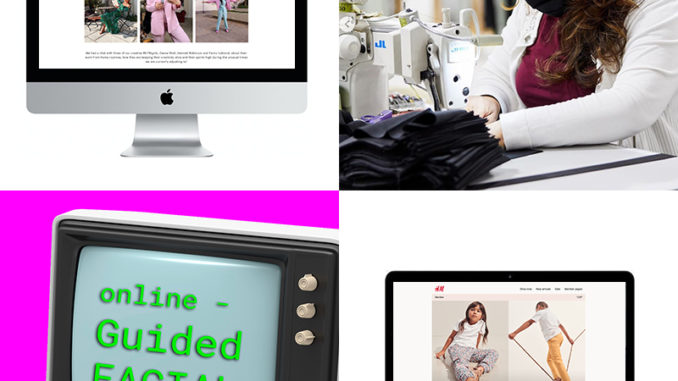
A fortnight ago, I received an email newsletter from a fashion brand, solemnly extolling the virtues of evening bags. Perhaps it slipped through the “time to delete pandemic-inappropriate content” net at the emergency, pre-lockdown, marketing team meeting. Perhaps a team member forgot to unschedule it on Mailchimp. Perhaps there is indeed someone, somewhere, cosily self-quarantining with a sequinned pochette. Regardless, it likely lost the brand subscribers – and a little respect.
In these economically uncertain times, it is essential that brands and retailers re-think their digital marketing strategies. It’s never been more important to be nimble, open and respectful, whether posting an Instagram Story or pressing “send” on an email campaign. Read on to discover the brands mastering the art of the pivot and how you can, too.
Recreate your brand experience, virtually
One might assume that physical service-based brands would be the first victims of lockdown. This is not so in the case of facialist Pfeffer Sal, who quickly introduced virtual treatments; customers receive products by post, before being treated to a “Guided Facial” through video conferencing. The company promoted the concept via Instagram Live called #PSLive, in which founder Andrea Pfeffer guided a DIY facial, for free.
Meanwhile, Bleach London nimbly pivoted marketing focus to their product line, launching “hair party packs” (sets featuring complementary products to achieve a specific hair colour). This was supported by a virtual, celebrity-attended launch party and an interactive hair quiz, on-site.
Give your customers the content they want
If in doubt, poll your biggest brand fans. As a pioneer in community marketing, Glossier’s peri-pandemic social media approach has been, unsurprisingly, exemplary. The cult beauty brand posted a cleverly innocuous video of a goat nibbling a chair, with a caption that asked followers, “What content do you guys want to see from us? How can we make your day a little better?” The post drove a high level of engagement, with commenters requesting staff tutorials, self-care tips and content that has “nothing to do with COVID-19”. Glossier acquiesced, thereafter posting get-the-look videos, UGC and memes. Then, they beta-launched Glossier Live Edit, a programme offering bookable one-to-one video chats with a ‘Live Editor’. Like many other brands, Glossier’s bricks-and-mortar boutiques are currently closed, and this initiative recreates an interactive store experience, at home.
Nourish your biggest brand fans
Pandemic-prompted discounting is inevitable. The question is, how can you offer additional value to your most loyal brand fans? Both MatchesFashion.com and H&M have seized the opportunity to focus on CRM, using segmented email campaigns to communicate exclusive discounts and pre-sales to members of their loyalty programmes. Self-isolation is supercharging online engagement, but this also means brands are more visible; an insensitive Instagram post or rashly-sent email could cost you followers and subscribers, so it is more important than ever to reward loyalty and keep VIP customers happy. This is also the perfect moment to concentrate on customer acquisition. Drive email sign-ups via organic and paid social campaigns, enticing potential customers with the promise of aforementioned member rewards and/or exclusive email discounts. Grow an engaged audience now; reap the benefits when this is all over.
Promote content over sales
Striking the balance between content and commerce can be tricky at the best of times, not to mention during a global pandemic. Take cues from Kitri; for every three product-focused emails the London-based indie brand sends, they also send one newsletter focusing on content. This primarily includes influencers (#KitriGirls) styling Kitri products, linking through to the brand’s blog; here, customers may dive into features on music and style inspiration, or they may click through to products. Meanwhile, Glossier has increased the ratio of content to product in their e-newsletters since the Coronavirus outbreak, sharing links to their YouTube and screenshots from their staff Slack channel. Crucially, both brands’ fiercely content-led approaches – even in these uncertain times – goes a long way in inspiring confidence in their customers. Even when pushing content seems counter-productive, brands must consider customer perception – aggressive sales may suggest desperation, and that could cause longer-lasting damage.
Honesty is the best policy
If brands decide to tackle Coronavirus head-on via a corporate initiative or otherwise, transparency is paramount. For sustainably-focused brand Reformation, skirting around the issue didn’t seem very on-brand. Instead, the LA-based retailer decided to use their factories to make masks for front-line workers. Instead of putting out a vague statement and risking criticism around the efficacy and grade of such masks, they released the following statement on Instagram: ‘The masks we’re making aren’t as good as medical-grade ones, but in the absence of medical masks, ours provide some much-needed protection for front-line workers. They’re made from double-layered dense woven fabrics, so if used correctly, and coupled with other safety practices, they’re a good alternative.’
Reformation is part of a new-wave of brands celebrating honesty and culpability over corporate polish, and their 1.6 million-strong Instagram following is proof. Whether communicating a pandemic-related product or talking about another potentiallDigital marketing in the time of Coronavirus: brands can weather the storm by pivoting their strategies,y sticky subject (eg. sustainability), brands who acknowledge their limits and aren’t afraid to open up the dialogue are winning community marketing.
Natalie Hughes is the Founding Director of The Fashion Digital, an agency specialising in digital marketing, social media, copywriting and content for brands, and whose clients include H&M, 7 For All Mankind, Rupert Sanderson and Ralph & Russo. Previously, Natalie held senior roles at Net-a-Porter, MatchesFashion.com and Christian Louboutin.
